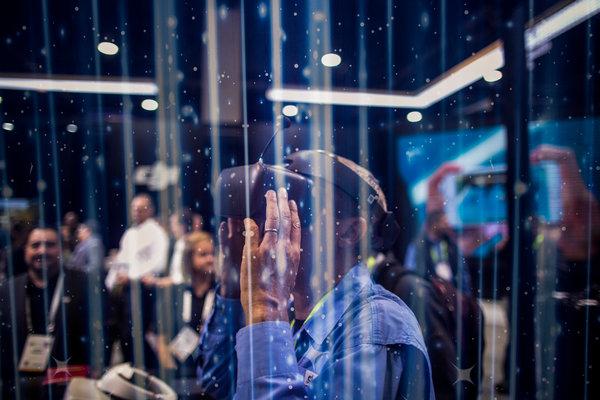May 9, 2019 – In his latest email blast, Peter Diamandis shares his insights on the next five years in the evolution of virtual and augmented reality. From seminars conducted at Diamandis-founded Singularity University, we continue to see contributions that show us a future roadmap for the advancement of science and technology in the 21st century. I have edited the content and commented on some of it to meet the requirements of this blog site. As always your comments and observations are appreciated.
In 2019 global spending on virtual and augmented reality (VR/AR) technology is projected to hit $20.4 billion US according to Philip Rosedale, the creator of Second Life, and co-founder of High Fidelity, exploring the next generation of shared VR.
Who are VR and ARs current major players?
- Microsoft with its HoloLens
- Facebook with Oculus
- Amazon with Sumerian
- Google with Cardboard
- And Apple with something promised
Rosedale sees plummeting prices and exponential advancements in hardware moving AR and VR from the early adopter market to mainstream consumers. In the next five years, he predicts the following five emerging trends to take hold disrupting major players and birthing new ones. “If you think you kind of understand what’s going on with that tech today, you probably don’t,” states Philip. “We’re still in the middle of landing the airplane of all these new devices.”
So what are the emerging trends of the next five years?
1. A Transition from PC-based to standalone mobile VR devices.
Historically, VR devices have relied on PC connections involving wires and clunky hardware that restrict a user’s field of motion. As VR enters the dematerialization stage, however, we are about to witness a rapid rise in standalone and highly mobile VR technology. Here are some examples:
Oculus Go, the leading standalone mobile VR device on the market, requires only a mobile app for setup and can be transported anywhere with WiFi. With a consumer audience in mind, the 32 Gigabyte headset is being priced at $200 USD and shares an application ecosystem with Samsung’s Gear VR. While Gear VR and Google Daydream are also standalone VR devices, they both require a docked mobile phone instead of the built-in screen of Oculus Go.
In the AR space, Lenovo’s standalone Mirage Solo and Microsoft’s HoloLens 2 lead the way in providing tetherless experiences.
Freeing headsets from the constraints of heavy hardware will make VR/AR increasingly interactive and transportable, a seamless add-on whenever, wherever. Within a matter of years, it may be as simple as carrying lightweight VR goggles wherever you go and throwing them on at a moment’s notice.
2. Wide field-of-view AR displays.
Microsoft’s HoloLens 2 leads the AR industry in headset comfort and display quality. The most significant issue with the prior version was its limited rectangular field of view (FOV). By implementing laser technology to create microelectromechanical systems (MEMS) display, however, the HoloLens 2 can position waveguides in front of user’s eyes, directed by mirrors. Enlarging images is accomplished by shifting mirror angles. Coupled with a 47 pixel per degree resolution, HoloLens 2 has doubled FOV from the previous model. Microsoft anticipates release of its headset by the end of 2019 at $3,500 USD with its first target businesses and eventually rolling out a version for everyday consumers.
Magic Leap is providing a similar FOV but lower resolution than HoloLens 2. Meta 2 boasts an even wider 90-degree FOV but requires a cable attachment. The race to achieve the natural human 120-degree horizontal FOV continues.
Rosedale obviously considers FOV to be a defining AR advancement. He comments, “The technology to expand the field of view is going to make these devices much more usable by giving you something bigger than a small box to look through.”
3. Mapping of the real world to enable persistent AR “Mirror Worlds.”
What are mirror worlds?
They are alternative realities that can blanket a physical space. While seated in your office, the floor beneath you could dissolve into a calm lake and each desk could become a sailboat. In the classroom, mirror worlds would convert pencils into magic wands and tabletops into touch screens.
Pokémon Go provides an introductory glimpse into the mirror world concept and the massive potential it represents to unite people in real action. But to create mirror worlds, AR headsets have to understand the architecture of the surrounding real world.
Rosedale predicts the scanning accuracy of devices is improving rapidly so that within the next five years we will see the introduction of alternate dimension realities.
4. 5G mobile devices reduce latency to imperceptible levels.
In the United States Verizon has launched 5G networks in two cities, Minneapolis and Chicago, using the Moto Z3 smartphone. Sprint has plans to follow with a 5G launch this month. And Samsung, LG, Huawei, and ZTE all have announced upcoming 5G devices. States Rosedale, “5G is rolling out this year and it’s going to materially affect particularly my work, which is making you feel like you’re talking to somebody else directly face to face.” The speed of the network will eliminate latency which Rosedale considers critical to face-to-face communication on mobile devices.
For standalone VR/AR devices to operate seamlessly in realtime requires a strong 5G network, enhancing connectivity and communication globally.
5. Eye-tracking and facial expressions built in for full natural communication.
Companies like Pupil Labs and Tobii are providing eye-tracking hardware add-ons and software to VR/AR headsets. This is technology that renders a given scene in high resolution in the fovea region of the retina, where visual acuity is highest, leaving peripheral regions in lower resolution, and conserving processing power.
As described earlier, eye tracking is a feature of the HoloLens 2. It can be used to identify a user and customize lens widths to provide a comfortable, personalized experience for that individual. According to Rosedale, “The fundamental opportunity for both VR and AR is to improve human communication,” which current VR/AR headsets demonstrate they are missing subtle yet important aspects like eye movement and microexpressions which provide valuable insights into a user’s emotions and desires. When coupled with emotion-detecting AI software, such as Affectiva, this will mean that VR/AR devices could soon convey much more richly textured and expressive interactions between people, transcending physical boundaries and even language.
Some final thoughts
The above advances will transform VR/AR technology into a consequential part of our lives and enriching our real world. It will revolutionize education by enabling holistic learning that incorporates social, emotional, and creative components through visceral experiences, storytelling, and simulation. VR/AR users will be able to travel to another time, manipulate the insides of a cell, or design a new city. In real estate, buyers will be able to make decisions using virtual tours. Corporate offices may evolve to become mirror world spaces for those who work remotely.
VR/AR advances will revolutionize healthcare improving the accuracy of diagnosis (see previous posting on this site about using VR for concussion diagnosis and recovery), enabling surgeons to use the technology in operations, and improving all aspects of manufacturing from training to assembly as VR/AR visual cues make complex tasks transparent.
A decade from now VR/AR will unlock limitless applications for new and converging industries. And as virtual worlds exploit the power of artificial intelligence, 3D printing, and other disruptive technological advancements, the evolving economy of that future will bear little resemblance to the one of today.









